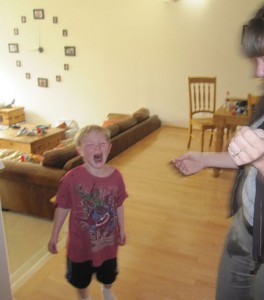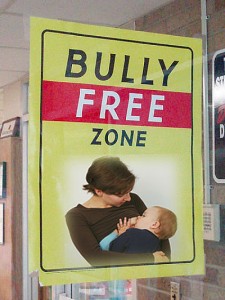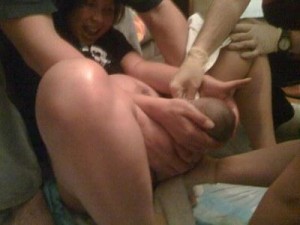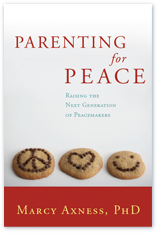Posts Tagged ‘brain development’
 We humans are rhythmic creatures. At least that’s how we’re meant to be. It’s why Rhythm is one of the seven Parenting for Peace principles. It is a gift for our children and ourselves to embrace life’s ebbing and flowing. Summertime offers us a luscious opportunity for slowing the pace of life.
We humans are rhythmic creatures. At least that’s how we’re meant to be. It’s why Rhythm is one of the seven Parenting for Peace principles. It is a gift for our children and ourselves to embrace life’s ebbing and flowing. Summertime offers us a luscious opportunity for slowing the pace of life.
“As biologists have learned in the past decade,” writes author Jennifer Ackerman, “time permeates the flesh of all living things — and for one powerful reason: We evolved on a rotating planet.”[1] She observes the many ways in which we carry inside us a model of the cosmos. Our entire being is steeped in various rhythms: respiration, circulation, digestion, elimination just to name a few.
So no wonder we find rhythmicity so nourishing. The young child most especially thrives on rhythmic routine, consistency and predictability. It weaves a sense of security into the fiber of his very cells as they are busy building brain and organ tissue. Ideally, rhythm permeates the child’s daily, weekly and even seasonal life. Meals and bedtimes are consistent and regular. Activities at home as well as outings take on the predictability of ritual, which the child can count on and keep a sort of internal beat to: “This is when we eat, this is when we nap, this is when we have play time… Tuesdays we go to the park, Wednesdays we go to the Farmer’s Market, Sunday we visit Grandma… and summer is beach time! {Read the rest of this post at mothering.com}
[1] Ackerman, Jennifer. Sex Sleep Eat Drink Dream: A Day in the Life of Your Body. New York: Houghton Mifflin, 2007, pg. 8.
Image:
Petrov Escarião under its Creative Commons license
Tags: brain development, Martha Beck, Michael Coyle, rhythm, Shawn Fink, summer, summer camp, summer school, tutoring
Posted in Parenting for Peace | No Comments »
We tend to throw around the word “attachment” a lot when talking about kids and parenting, so let’s make sure we’re all talking about the same thing: attachment is a measure of the security of relationship between a child and those one or two or three adults with whom that child is in consistent contact. We now recognize that healthy (secure) attachment is a fundamental form of nourishment for a child’s growing brain. In particular, attachment fosters rich circuitry in the area of the brain that mediates social and emotional functioning. A parent’s ability to be present for a child is fundamental to fostering this brain circuitry needed to regulate attention — therefore, basic ADHD treatment. Mounting research suggests that the social brain is the basis for the child’s lifelong success — in school, at home, and out in the world! (more…)
Tags: ADD, adhd, attachment, brain development, Dan Siegel, Gabor Mate, presence, social brain
Posted in Parenting for Peace | 2 Comments »
 So there you are one afternoon, at the end of your rope with an out-of-control three-year-old. You know you won’t spank him, and you have become mindful of avoiding shame-based measures, so what’s left? Is “Time Out” the answer? At risk of bringing on the wrath of parents everywhere, my answer is no. Time-outs were conceived as a more humane alternative to spanking, but the problem is, they land a blow to the brain and psyche rather than to the bottom.
So there you are one afternoon, at the end of your rope with an out-of-control three-year-old. You know you won’t spank him, and you have become mindful of avoiding shame-based measures, so what’s left? Is “Time Out” the answer? At risk of bringing on the wrath of parents everywhere, my answer is no. Time-outs were conceived as a more humane alternative to spanking, but the problem is, they land a blow to the brain and psyche rather than to the bottom.
Right at the moment when the child is overwhelmed by a flood of emotions he cannot manage, and he most needs the regulating presence — that is, close physical presence — of his attachment figure, he’s banished to his room or his “Naughty Chair” or his “Thinking Rug” or his [fill in the blank with any of a list of prettied-up names people have devised for this particular form of exile]. (more…)
Tags: attachment, brain development, discipline, Gordon Neufeld, shame, social brain, spanking, time-out
Posted in Parenting for Peace | No Comments »

Yes, that’s really Ian!
Yes, I spanked my son. It was almost twenty years ago but I still remember it vividly. Ian was six or seven and was stubbornly, defiantly ignoring me right to my face. (About what? Now that I cannot recall!) Something primitive inside me uncoiled and I was suddenly spanking him. I regretted it immediately and ever since — not just for the obvious reason of having been violent with him, but also for the sliver of his respect I lost in that moment.
We lose the admiration of our children when we “lose it.” It’s a mammalian thing: all animal behaviorists know that our ability to have authority over — and thus the ability to train — a dog or a horse is severely eroded if the animal sees or feels us get angry. Credible leaders don’t lose their composure, it’s as simple as that. Of course children aren’t dogs, but we can learn so much from understanding the mammalian similarities! Our children’s respect and admiration are among the most potent tools in our parenting toolbox, and if we do things to erode them, we set ourselves up for trouble down the line. (more…)
Tags: brain development, imitation, spanking
Posted in Parenting for Peace | 2 Comments »
 Gone are the days when we could consider pregnancy a 9-month “grace period” before the job of parenting begins. Mounting research tells us that lifelong wellbeing, including mental health, begins in the womb, and everything parents do – beginning even before conception — shapes their children in critical, life-altering ways.
Gone are the days when we could consider pregnancy a 9-month “grace period” before the job of parenting begins. Mounting research tells us that lifelong wellbeing, including mental health, begins in the womb, and everything parents do – beginning even before conception — shapes their children in critical, life-altering ways.
I began 2013 by writing about the power of beginnings. This applies to virtually everything, from baking a pie to building a company to developing a human: the beginning contains within it the seeds of the project’s ultimate success…or less-than-success. (more…)
Tags: autism, brain development, fetal origins, oxytocin, pregnancy, prenatal epigenetics, stress
Posted in Parenting for Peace | 3 Comments »
 So many questions in the wake of Newtown, and an excellent one is about how television violence affects children. As some of the wiser commentators have said, there is no one single reason (not just guns, not just mental illness, not just family dynamics) for a tragedy of such heinous proportions. The question of how television violence affects children is just one thread of the complex tapestry of causes in such tragedies as the Newtown massacre.
So many questions in the wake of Newtown, and an excellent one is about how television violence affects children. As some of the wiser commentators have said, there is no one single reason (not just guns, not just mental illness, not just family dynamics) for a tragedy of such heinous proportions. The question of how television violence affects children is just one thread of the complex tapestry of causes in such tragedies as the Newtown massacre.
This tapestry surely finds its warp threads in the early days of a child’s life as the social brain is wiring up — during pregnancy, in infancy, toddlerhood and childhood. Important weaving also takes place in the equally tender developmental stages around adolescence. (more…)
Tags: ADD, adolescent brain, attention, brain development, Newtown, social brain, television, violence
Posted in Parenting for Peace | No Comments »
 How perfect that October is Bullying Prevention Month and Attachment Parenting month — since healthy attachment is the first best anti-bullying program! Healthy attachment is the wellspring optimal brain development, especially the social brain circuitry that governs such anti-bullying capacities as self-regulation, empathy, trust, emotional and cognitive flexibility, and imagination.
How perfect that October is Bullying Prevention Month and Attachment Parenting month — since healthy attachment is the first best anti-bullying program! Healthy attachment is the wellspring optimal brain development, especially the social brain circuitry that governs such anti-bullying capacities as self-regulation, empathy, trust, emotional and cognitive flexibility, and imagination.
As I’ve written about in a prior post about the origins of empathy, my opinion (in agreement with many others) is that even the very best school-based anti-bullying or conflict resolution program puts the change lever in the wrong place — that is, way too far down a child’s developmental timeline: (more…)
Tags: attachment, attachment neurobiology, Attachment Parenting Month, brain development, Bruce Perry, Bullying Prevention Month, empathy, Jamie Lynne Grumet, pleasure, sociopathy, violence
Posted in Parenting for Peace | No Comments »
Parenting for Peace
 Make no mistake: mothers can change the world. And now is the time for us to realize it. Through recognizing our true nature and innate power, together with the shaping impact of how we bring children to life and to maturity, we can wield timely and imperative healing change.
Make no mistake: mothers can change the world. And now is the time for us to realize it. Through recognizing our true nature and innate power, together with the shaping impact of how we bring children to life and to maturity, we can wield timely and imperative healing change.
The Dalai Lama said at the Vancouver Peace Summit that the world will be saved be the western woman. In the midst of our global human, economic and environmental crises, we have been overlooking a powerful — perhaps the most powerful — means of changing the world toward more peace and prosperity: the consciousness with which we bring our children to life and shepherd them into adulthood. (more…)
Tags: brain development, imagination, intellegence, interpersonal neurobiology, parenting for peace, peace, self-regulation
Posted in Parenting for Peace | No Comments »
 Along with the cascade of benefits that most Mothering readers already know comes with vaginal birth, new research from Yale has identified yet another: vaginal birth triggers the expression of a protein in baby’s brain cells that optimizes development of the hippocampus — an area central to such “complex behaviors in the adult” as learning, memory, and stress response. C-section delivery may actually impair this protein’s expression.
Along with the cascade of benefits that most Mothering readers already know comes with vaginal birth, new research from Yale has identified yet another: vaginal birth triggers the expression of a protein in baby’s brain cells that optimizes development of the hippocampus — an area central to such “complex behaviors in the adult” as learning, memory, and stress response. C-section delivery may actually impair this protein’s expression.
I find it of interest that earlier this year another study came out linking early nurturing by mothers with larger hippocampal regions in school-aged children. And while the Yale study is very preliminary — using mice, not humans — to me it all points to a notion I hold dear: Nature has an elegant plan for the unfolding of optimal human intelligence (including the required brain structures to mediate that intelligence), and it involves such quaintly natural things as birthing through the birth canal and letting mothers closely nurture their young ones! {Please continue reading at mothering.com}
Tags: birth, brain development, breast milk, breastfeeding, C-section, vaginal birth
Posted in Parenting for Peace | 2 Comments »
The Power of Parental Example
[Even though I refer to the “mommy” mind meld, these principles apply to whomever are the two or three connected, nurturing adults in an infant’s life — father, grandmother, consistent (not rotating) caregiver.] 
Imitation is the young child’s primary form of learning, which is why one of my first bits of guidance to parents coming to me for counseling is (more…)
Tags: brain development, epigenetics, fetal brain development, interpersonal neurobiology, mindfulness, social intelligence, striving
Posted in Parenting for Peace | No Comments »
 We humans are rhythmic creatures. At least that’s how we’re meant to be. It’s why Rhythm is one of the seven Parenting for Peace principles. It is a gift for our children and ourselves to embrace life’s ebbing and flowing. Summertime offers us a luscious opportunity for slowing the pace of life.
We humans are rhythmic creatures. At least that’s how we’re meant to be. It’s why Rhythm is one of the seven Parenting for Peace principles. It is a gift for our children and ourselves to embrace life’s ebbing and flowing. Summertime offers us a luscious opportunity for slowing the pace of life. So there you are one afternoon, at the end of your rope with an out-of-control three-year-old. You know you
So there you are one afternoon, at the end of your rope with an out-of-control three-year-old. You know you 
 Gone are the days when we could consider pregnancy a 9-month “grace period” before the job of parenting begins. Mounting research tells us that lifelong wellbeing, including mental health, begins in the womb, and everything parents do – beginning even before conception — shapes their children in critical, life-altering ways.
Gone are the days when we could consider pregnancy a 9-month “grace period” before the job of parenting begins. Mounting research tells us that lifelong wellbeing, including mental health, begins in the womb, and everything parents do – beginning even before conception — shapes their children in critical, life-altering ways. So many questions in the wake of
So many questions in the wake of  How perfect that October is Bullying Prevention Month and Attachment Parenting month — since healthy attachment is the first best anti-bullying program! Healthy attachment is the wellspring optimal brain development, especially the social brain circuitry that governs such anti-bullying capacities as self-regulation, empathy, trust, emotional and cognitive flexibility, and imagination.
How perfect that October is Bullying Prevention Month and Attachment Parenting month — since healthy attachment is the first best anti-bullying program! Healthy attachment is the wellspring optimal brain development, especially the social brain circuitry that governs such anti-bullying capacities as self-regulation, empathy, trust, emotional and cognitive flexibility, and imagination. Make no mistake: mothers can change the world. And now is the time for us to realize it. Through recognizing our true nature and innate power, together with the shaping impact of how we bring children to life and to maturity, we can wield timely and imperative healing change.
Make no mistake: mothers can change the world. And now is the time for us to realize it. Through recognizing our true nature and innate power, together with the shaping impact of how we bring children to life and to maturity, we can wield timely and imperative healing change. Along with the cascade of benefits that most Mothering readers already know comes with vaginal birth,
Along with the cascade of benefits that most Mothering readers already know comes with vaginal birth, 


